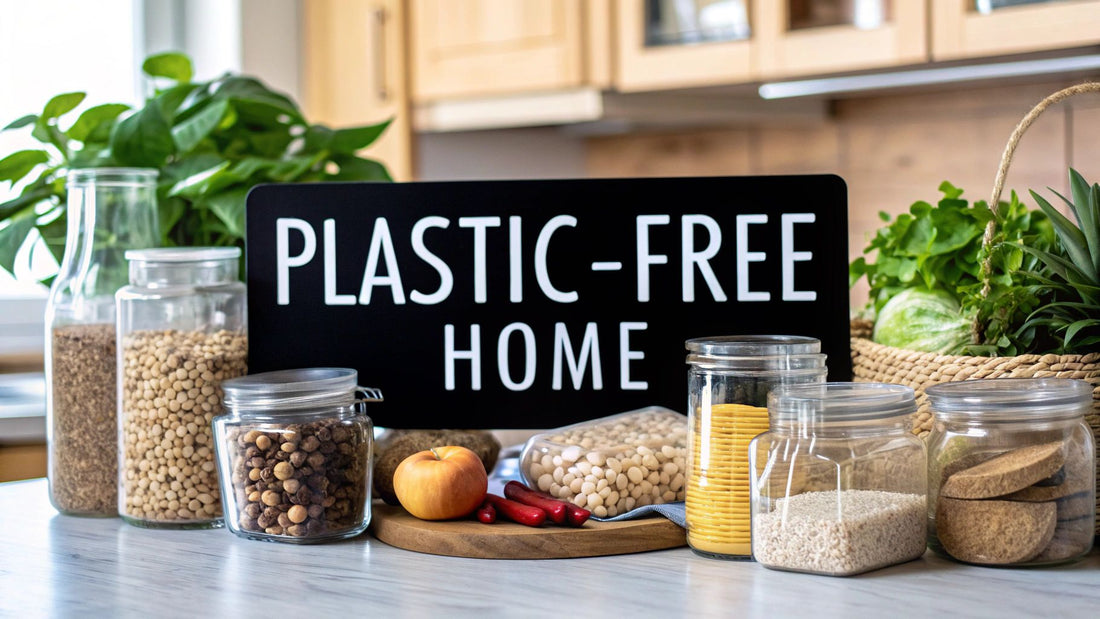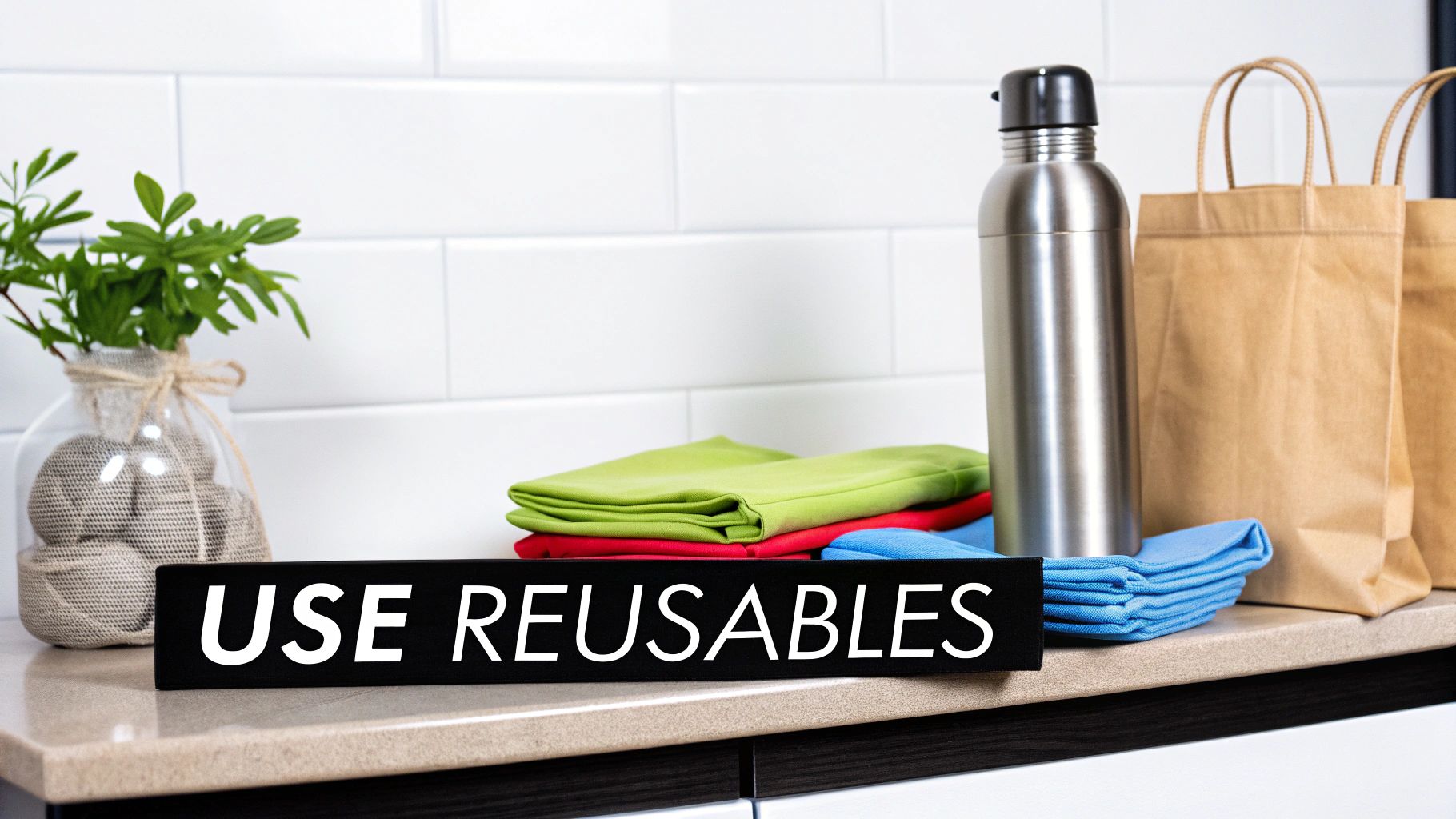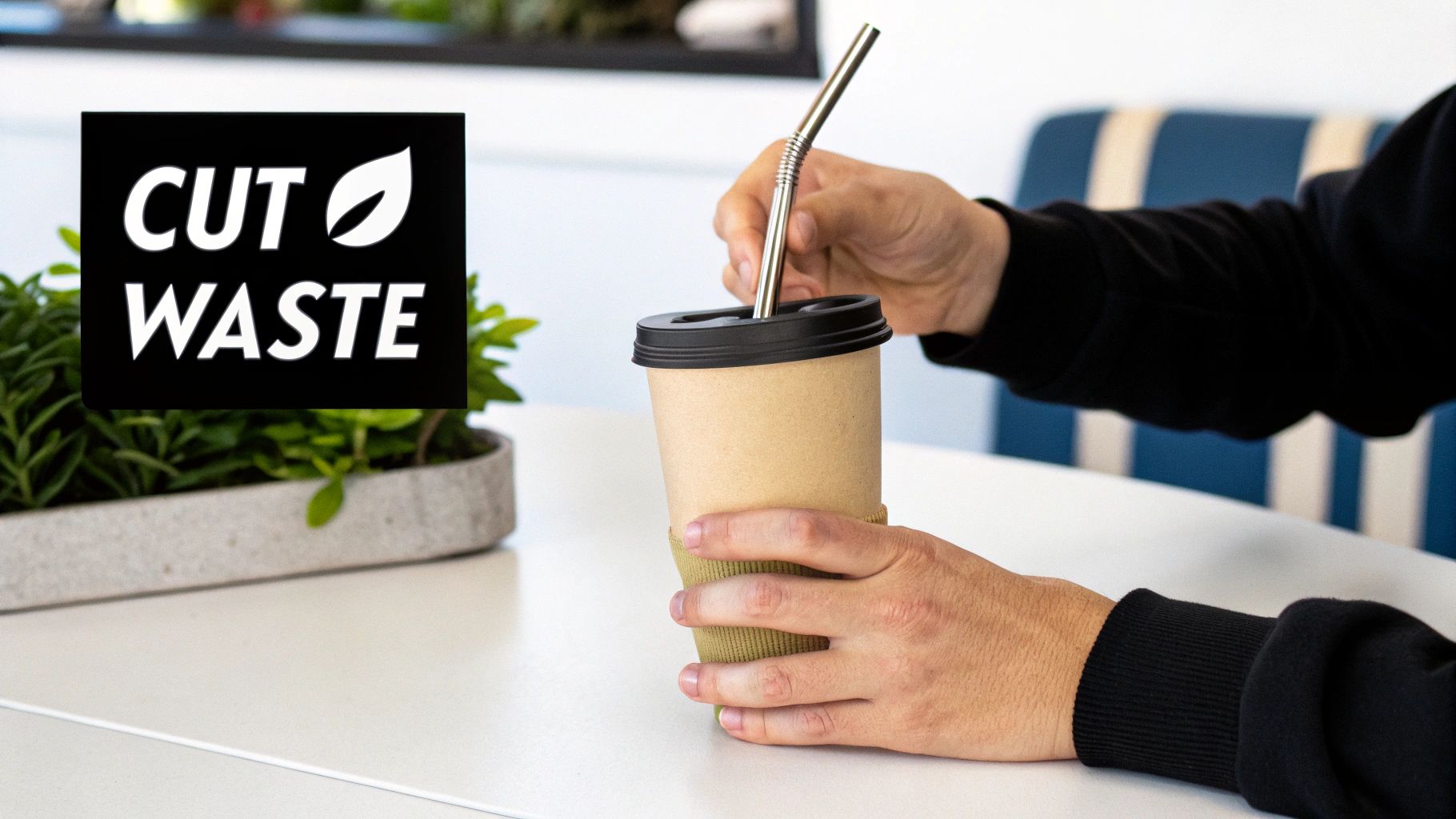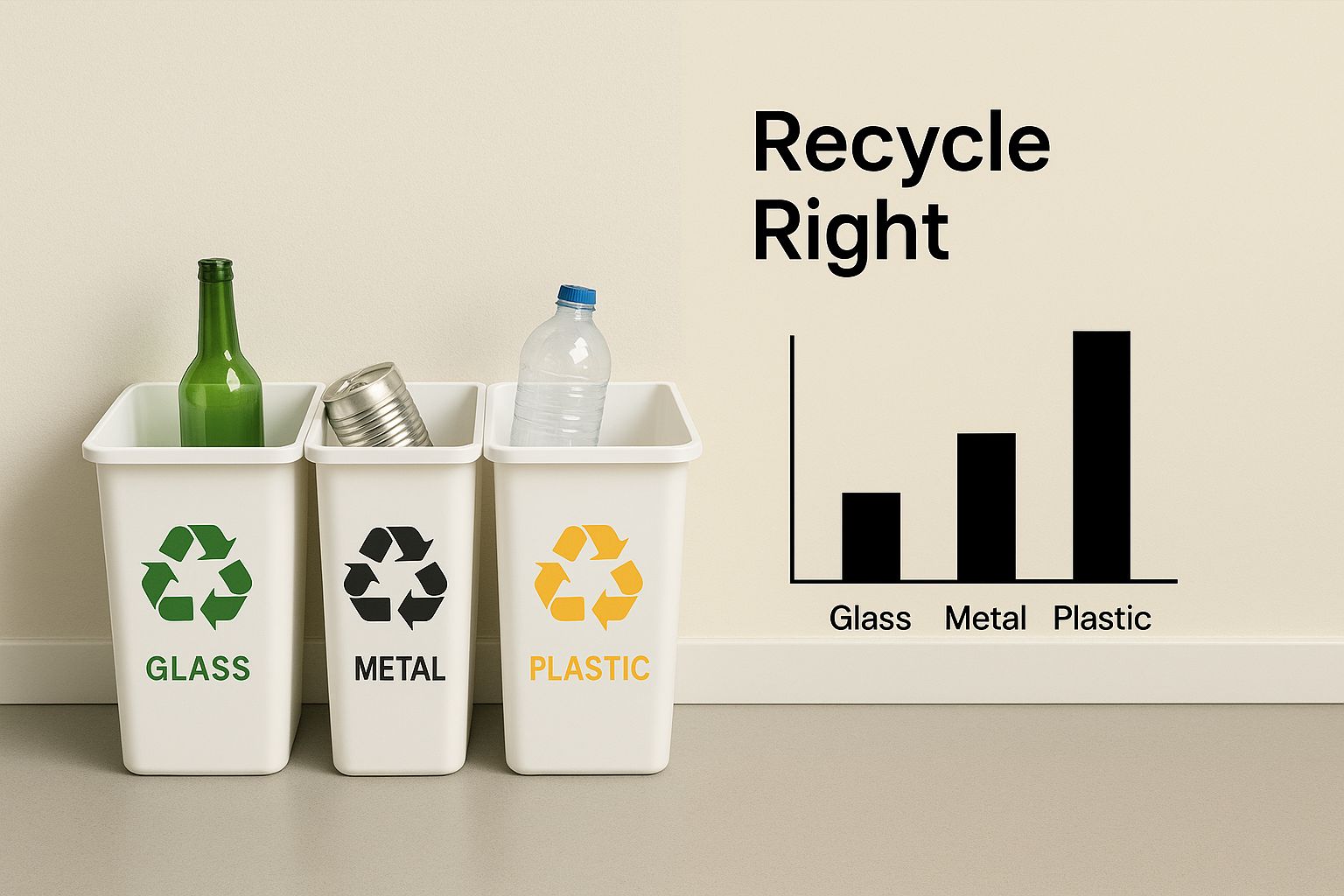
How to Reduce Plastic Waste: A Guide to a Cleaner Home
Share
Figuring out how to reduce plastic waste isn't just about learning new tricks; it's about understanding why your choices matter in the first place. This goes way beyond sorting your recycling bin correctly. It's about the small, conscious decisions that, when we all make them, add up to a massive shift in our collective environmental footprint.
Why Reducing Plastic Waste Actually Matters

The sheer scale of global plastic pollution can feel overwhelming. It’s easy to hear about things like the Great Pacific Garbage Patch and think your personal habits are just a drop in an incredibly polluted ocean. But the problem isn't just "out there." It's directly tied to what we put in our shopping carts and line our pantry shelves with.
Your everyday choices are truly the bedrock of large-scale change. The journey to a world less choked by plastic starts with seeing the real-world impact of what we buy and throw away. When you make that connection, it stops feeling like a chore and starts feeling like a powerful, meaningful act.
The Sobering Reality of Mismanaged Waste
A huge piece of the puzzle is what experts call "mismanaged waste." This is the stuff that never makes it into a formal waste system—it's the plastic that's likely to end up polluting our soil, rivers, and oceans.
It's a staggering thought, but by 2025, it's estimated that nearly 32% of all plastic produced will become mismanaged waste. Even with better recycling technology, we're making so much new plastic that the amount getting lost in the environment is still shockingly high. You can explore the data on plastic overshoot to see just how far production has outpaced our ability to manage the aftermath.
This brings home a critical truth: we can't recycle our way out of this crisis. The real work happens at the source, by cutting down on what we use in the first place.
The most impactful changes we can make are refusing single-use items and reusing what we already own. These two actions prevent waste from ever being created, which is far more effective than managing it after the fact.
An Overview of Core Strategies
Tackling the plastic problem means adopting a mindset that goes far beyond the recycling bin. This guide is built to give you practical, real-world strategies that make a genuine difference. We'll zero in on the key areas of your life where small shifts in habit can deliver the biggest results.
To give you a roadmap of what’s ahead, here’s a quick summary of the main action areas we'll be diving into. These are the pillars of a sustainable, low-plastic lifestyle.
| Action Area | Primary Goal | Example Tactic |
|---|---|---|
| Rethinking Grocery Shopping | Intercept plastic before it enters your home. | Bringing your own reusable produce bags and containers to the store. |
| Building a Sustainable Kitchen | Eliminate disposables from daily food prep, storage, and cleanup. | Swapping plastic wrap for reusable beeswax wraps or silicone lids. |
| Expanding Beyond the Kitchen | Target hidden plastics in other areas of the house. | Opting for solid shampoo and conditioner bars to ditch plastic bottles. |
| Impacting the Bigger Picture | Amplify your personal efforts by supporting systemic change. | Asking local businesses to offer package-free options or refills. |
By focusing on these areas, you're not just reducing your personal waste—you're building a foundation of habits that will reshape your relationship with consumption for the long haul. Let's get started.
Rethinking Your Grocery Shopping Habits

The grocery store is ground zero for plastic. It’s where our best intentions often crumble against a wall of shrink-wrapped cucumbers, clamshells of berries, and countless other packaged goods. It can feel like an impossible fight.
But here’s the thing: the grocery store is also where you have the most direct power to cut plastic out of your life before it even crosses the threshold of your home.
A successful low-waste shopping trip doesn’t happen by accident. It starts with a few minutes of prep at home—not a huge chore, just a new routine. With the right tools and a fresh mindset, you can make a serious dent in the amount of plastic you bring back.
Assemble Your Zero-Waste Shopping Kit
The absolute cornerstone of a plastic-free grocery run is having your kit ready to go. My advice? Keep it all in your car or right by the door so you can just grab it and go. This is how a new habit becomes second nature. Think of it as your anti-plastic arsenal.
- Reusable Shopping Bags: This one’s a no-brainer. A good stash of sturdy totes in the trunk means you’ll never need a plastic bag at checkout again.
- Mesh Produce Bags: These are a game-changer. I use these lightweight, washable bags for loose produce like apples, onions, potatoes, and even leafy greens. They completely replace those flimsy, single-use plastic bags in the produce aisle.
- Glass Jars and Containers: Essential for bulk bins, the deli counter, or the butcher. Bring clean jars for things like nuts, seeds, and spices. A couple of clean glass containers are perfect for getting cheese or sliced meats without the usual plastic wrap and styrofoam tray.
- Cloth Bags for Bulk Goods: For finer things like flour, coffee beans, or lentils, I find that smaller cloth bags with a tighter weave work best. They keep everything contained without spilling through the holes in a mesh bag.
Having this kit on hand removes the single biggest obstacle. You won't get caught off guard and have to fall back on the store's plastic.
Navigating the Aisles with a New Perspective
Once you’re in the store, your mission is to actively hunt for the unpackaged options. This requires a small but important shift in how you look at the shelves. Instead of automatically reaching for the most convenient item, pause and scan for a plastic-free alternative.
For example, when you’re in the produce section, make a deliberate choice to buy loose carrots, mushrooms, or bell peppers instead of the ones pre-packed in plastic bags or on styrofoam trays. This one small decision, when you repeat it across your entire shopping list, adds up to a huge impact.
Key Takeaway: Remember, the goal is progress, not perfection. If you forget your bags one day or the only option for an ingredient you truly need is wrapped in plastic, don’t beat yourself up. Every single time you choose a plastic-free alternative, you're winning.
This mindset goes beyond just produce. Look for condiments like mustard or ketchup in glass jars instead of plastic squeeze bottles. Choose milk in returnable glass bottles or cardboard cartons over plastic jugs. These little swaps really do add up over the course of a year.
Mastering the Bulk Bin and Deli Counter
The bulk section is your best friend in the fight against plastic waste. It allows you to buy the exact amount you need—which helps reduce food waste, too—with zero packaging.
Here’s how to approach it with confidence:
- Tare Your Container: First, take your empty jar or container to a cashier or the customer service desk. Just ask them to weigh it and write the "tare" weight on it. This step ensures you only pay for the food inside, not the weight of your container.
- Fill It Up: Now for the fun part. Head to the bulk bins and fill your container.
- Write the PLU Number: Use a grease pencil (many stores have them in the bulk aisle) or a small label to jot down the product look-up (PLU) number on your jar. This makes the cashier's job a breeze at checkout.
You can bring that same confidence to the deli or butcher counter. Simply hand over your clean container and ask, "Could you please put my order in here instead of using new plastic?" In my experience, most employees are happy to help. You might even inspire the person behind you in line!
The impact of avoiding pre-packaged goods is massive. Single-use plastics are the main driver of plastic pollution, with an estimated 85% of single-use plastic packaging ending up as waste in landfills or our environment. When you shift your shopping habits, you're directly tackling this huge problem. You can discover more insights about the environmental impact of plastic and see just how powerful individual choices can be. Rethinking your grocery routine is one of the most effective ways you can be part of the solution.
Building a Sustainable Kitchen and Pantry
All your hard work at the grocery store is a huge win, but the real challenge often starts when you get home. Let's be honest: the kitchen is the heart of the home, but it’s also ground zero for plastic waste. From food storage to daily cleanup, single-use plastics have wormed their way into nearly every routine.
But transforming your kitchen into a low-plastic sanctuary doesn't require a sudden, expensive overhaul. It's really about making a series of small, thoughtful swaps that make plastic-free living feel completely second nature. You'll not only slash your waste but also end up with a more beautiful, organized, and functional space that just feels good to be in.
Master Plastic-Free Food Storage
One of the biggest culprits of kitchen plastic? Food storage. Just think about it for a second—flimsy cling wrap, single-use Ziploc bags, and those stacks of takeout containers. The good news is that the alternatives are usually better, healthier, and look a whole lot nicer.
When you get home with all those goodies from the bulk bins, the first thing to do is decant them. Moving grains, nuts, seeds, and spices from their temporary bags into glass jars gives your pantry an instant upgrade. It doesn’t just look fantastic on your shelves; it also keeps food fresher for longer and lets you see exactly what you have at a glance, which helps cut down on food waste.
For leftovers or covering bowls, it's time to ditch the plastic wrap for good. Here are some of my favorite reusable swaps:
- Beeswax Wraps: These pliable, naturally antibacterial wraps are brilliant for covering bowls, wrapping sandwiches, or storing cut produce like half an onion.
- Silicone Lids: These super-stretchy lids come in various sizes and create an airtight seal on bowls, jars, and even open cans.
- Glass Containers: Investing in a quality set of glass containers with durable lids is a total game-changer. They’re perfect for meal prep and storing leftovers, plus they can go straight into the microwave, oven (lid off!), and freezer.
By swapping disposable food storage for reusable options, you're not just cutting out plastic; you're investing in tools that will last for years, saving you money in the long run and keeping potentially harmful chemicals away from your food.
This visual guide shows how proper sorting is still a key part of a sustainable system, even after we’ve done our best to reduce and reuse.

The image is a great reminder that after we've minimized our waste, correctly managing the remaining recyclables is the final, crucial step.
Embrace the Power of DIY Staples
Another incredibly effective way to reduce plastic is to simply stop buying things that come in it. So many common pantry items are surprisingly easy—and much tastier—to make from scratch. When you make it yourself, you control the ingredients, skip the preservatives, and eliminate the packaging waste entirely.
Why not start with one of these simple DIY projects?
- Salad Dressing: A classic vinaigrette is just oil, vinegar, and some seasoning shaken up in a jar. It takes less than two minutes and tastes worlds better than the stuff in plastic bottles.
- Granola: Instead of buying granola in plastic bags, just mix some oats, nuts, seeds, and a little maple syrup and oil, then bake it all until golden brown. Your kitchen will smell incredible, and you’ll have a healthy breakfast ready for the week.
- Vegetable Broth: Keep a bag or container in your freezer for veggie scraps—think onion peels, carrot ends, and celery tops. Once it’s full, simmer the scraps in water for about an hour, then strain. You’ve just made delicious, free broth and avoided another plastic-lined carton.
Making these staples yourself creates a deeper connection to your food and really shines a light on how much packaging we accept without a second thought.
Make Smart Kitchen Swaps
Beyond food, your daily cleanup tools offer a massive opportunity to ditch plastic. So many conventional kitchen items are designed to be thrown away, but their sustainable counterparts are actually built to last.
Take a look around your sink. How many plastic items do you see? A plastic dish brush? A synthetic sponge? A plastic bottle of dish soap? Every single one has a simple, effective, and often more beautiful alternative. Making these changes is one of the most direct ways to learn how to reduce plastic waste in your day-to-day life.
Making a few smart swaps in your kitchen can dramatically reduce your plastic footprint over time. Here’s a quick comparison of some easy changes you can make.
Easy Plastic-Free Kitchen Swaps
| Common Plastic Item | Sustainable Alternative | Long-Term Benefit |
|---|---|---|
| Plastic Dish Brush | A wooden dish brush with replaceable, plant-fiber heads. | You only replace the small head, not the entire brush, significantly reducing waste. |
| Synthetic Sponges | Compostable loofah sponges or Swedish dishcloths. | These break down naturally in a compost pile instead of sitting in a landfill for centuries. |
| Plastic Liquid Soap Bottle | A solid dish soap bar or refilling a glass dispenser. | Eliminates plastic bottle waste entirely and often uses fewer, simpler ingredients. |
| Paper Towels | Reusable cloth towels or Swedish dishcloths. | One cloth can do the work of dozens of paper towel rolls, saving trees and money. |
These swaps might seem small on their own, but their collective impact is huge. Every time you choose a reusable or compostable tool over a disposable plastic one, you’re casting a vote for a healthier planet. Your kitchen becomes living proof that sustainability and practicality can—and should—go hand in hand.
Taking a Low-Plastic Mindset Beyond the Kitchen
Getting your kitchen sorted is a huge win, but plastic is sneaky. It has a way of working itself into every part of our homes—the bathroom, the laundry room, even our closets.
Once you start looking, you’ll see it everywhere. But don't get overwhelmed. The swaps for these other areas are often just as simple and, frankly, quite satisfying. When you apply this thinking across your whole home, it stops being a "kitchen project" and starts becoming a natural, sustainable lifestyle. It’s all about creating a cohesive system for a cleaner home and a healthier planet.
Reimagining Your Bathroom Routine
Let’s be honest: the bathroom is usually a graveyard for single-use plastic bottles. Shampoo, conditioner, body wash, face wash, hand soap, lotion... it adds up to a mountain of plastic over a lifetime. The good news? This is one of the easiest places to make a massive dent in your plastic footprint with just a few clever changes.
Solid toiletries have completely changed the game. Here are some of my favorite swaps to get you started:
- Shampoo and Conditioner Bars: A single shampoo bar can easily replace two or three plastic bottles. They work beautifully, are perfect for travel, and leave zero packaging behind.
- Solid Soap Bars: It’s time to bring back the classic bar of soap for your hands and body. Just look for one wrapped in paper or cardboard to completely ditch the plastic.
- Bamboo Toothbrushes: A bamboo toothbrush is a brilliant swap for the plastic version. When you're done, the handle can be composted, leaving only the tiny nylon bristles to throw away.
Making these shifts not only slashes your plastic use but often leads you to products with simpler, more natural ingredients. It’s a win-win.
Switching to solid or refillable bathroom products does more than just cut down on waste. It declutters your shower, simplifies your morning routine, and sends a powerful message that personal care doesn't need to come in a disposable plastic bottle.
Cleaning Up Your Laundry Habits
The laundry room is another spot where plastic tends to pile up. Those giant plastic jugs of detergent and fabric softener are the norm, but they create so much unnecessary waste. For perspective, the beauty industry alone churns out over 120 billion units of packaging each year. While detergent isn't makeup, the packaging problem runs parallel.
Thankfully, there are fantastic alternatives that get your clothes just as clean without the clunky plastic jug.
Consider making one of these powerful changes:
- Detergent Sheets or Strips: These are super-concentrated, dehydrated sheets of detergent that simply dissolve in the wash. They come in a small, recyclable cardboard box and are incredibly lightweight, which also shrinks their shipping carbon footprint.
- Powdered Detergent in a Box: This one’s an old-school classic for a good reason. Grabbing a cardboard box of powdered detergent is one of the easiest ways to sidestep a big plastic container.
- Wool Dryer Balls: Ditch single-use dryer sheets, which are often packed with synthetic fragrances and aren’t biodegradable. Reusable wool dryer balls soften clothes, cut down on drying time, and last for hundreds of loads.
These swaps work just as well as their liquid-in-a-jug counterparts, but without the environmental baggage.
Addressing the Microplastic Problem in Your Closet
The plastic problem even weaves its way into the clothes we wear. So many of our modern fabrics—like polyester, nylon, and acrylic—are just different forms of plastic.
Here’s the invisible issue: every time we wash these synthetic materials, they shed thousands of microscopic plastic fibers called microplastics. These fibers are too small for wastewater treatment plants to filter out, so they flow directly into our rivers and oceans.
One of the most impactful things you can do is to choose natural fibers whenever possible. When you're shopping for new clothes, keep an eye out for materials like:
- Cotton (organic is even better)
- Linen
- Hemp
- Wool
- Tencel (sustainably made from wood pulp)
This doesn't mean you need to purge your entire wardrobe tomorrow. Just start by being more intentional and checking the labels on new purchases. For the synthetic clothes you already own, washing them in a special laundry bag designed to catch microfibers can make a real difference. Thinking about what our clothes are made of is a crucial, but often overlooked, piece of the plastic-free puzzle.
Of course. Here is the rewritten section, designed to sound natural and human-written, as if from an experienced expert.
Making an Impact Beyond Your Own Home
It’s one thing to get your own kitchen in order, but let's be honest—the plastic problem is much bigger than any one of us. While making conscious choices at home is a fantastic start, the real magic happens when we connect our personal efforts to the bigger picture. This is how we turn individual habits into a powerful movement for change.
For years, we’ve all been taught the mantra: "Reduce, Reuse, Recycle." But the emphasis always seemed to land on that last word. The reality is, the first two—Reduce and Reuse—are where the real power lies. They stop waste before it even starts, which is a whole lot more effective than figuring out what to do with a mountain of trash later.
The Honest Truth About Recycling
Let's talk about recycling. It's often hailed as the ultimate solution, but it’s far from a silver bullet. The system is frankly broken. Many plastics can't be recycled in the first place, and a shocking amount of what we toss in the bin never actually gets processed.
This brings us to the well-intentioned but problematic habit of "wish-cycling"—throwing something in the recycling bin hoping it can be recycled. We've all done it. But this can contaminate entire batches of materials, forcing everything to be sent to the landfill anyway. It’s a hard truth, but we simply can't recycle our way out of the plastic crisis. The sheer volume of plastic being pumped out into the world is just too much to handle.
And this isn't just a local issue. When you look at where plastic waste ends up, you see a global problem. The countries contributing most to ocean plastic pollution include the Philippines (36%), India (12.92%), and Malaysia (7.46%). This is a complex web of international waste trade and struggling infrastructure, leading to plastic leaking directly into our oceans. You can discover more about the global flow of plastic pollution on rts.com to truly grasp how interconnected it all is.
How to Advocate for Systemic Change
This is where your influence can really grow. By using your voice—and your wallet—you can push for the kind of large-scale changes needed to tackle plastic pollution at its source. Think of it as amplifying your daily efforts.
Here are a few ways to start making a bigger impact:
-
Vote with Your Dollars: Seek out and champion businesses that are genuinely trying to reduce their plastic footprint. When you shop with brands that prioritize plastic-free packaging, you’re doing more than just buying a product; you're sending a loud and clear message to the market that you want responsible options.
-
Speak Up (Politely!): Don't be shy about voicing your preferences. If your local cafe only offers single-use cups, ask if they'd consider a discount for bringing your own reusable one. A quick email or social media message to a brand you love, asking for package-free products, can make a surprising difference.
Your feedback as a customer is one of the most powerful tools you have. Businesses listen to customer demand, and a polite, consistent message can genuinely influence their packaging decisions over time.
- Get Involved Locally: Look for opportunities right in your own community. It could be as simple as joining a local cleanup day, which is a great way to raise awareness and see the problem firsthand. You might also find local groups pushing for policies like plastic bag bans or better composting programs. Getting involved at the grassroots level is how real, lasting change begins.
Answering Your Questions About Going Plastic-Free
Getting started on a low-waste journey is exciting, but let's be honest—it doesn't take long for the real-world questions and roadblocks to appear. It's one thing to have a plan, but a whole different challenge to stick with it when life gets in the way.
This is where we tackle those common hurdles. Think of this as a non-judgmental Q&A session to help you troubleshoot and keep the momentum going.
"Help! My Grocery Store Has No Bulk Bins."
This is probably one of the most common and frustrating moments for anyone starting out. You arrive at the store, reusable bags and jars in hand, only to find there’s no bulk section to be found. It’s easy to feel defeated, but don't give up.
Instead of focusing on what your store lacks, pivot to what it does offer.
- Live in the Produce Aisle: This section is your best friend. Always opt for loose fruits and veggies over the ones trapped in plastic bags or shrink-wrap. Bring your own mesh produce bags to keep things tidy at checkout.
- Look for Glass, Paper, and Metal: When you're grabbing pantry staples like pasta sauce, oats, oils, or beans, make a conscious effort to choose brands packaged in glass jars, paper boxes, or metal cans.
- Make Friends at the Counter: Don't be shy at the deli or butcher counter. Just ask politely if they can place your cheese or meat directly into a clean container you brought from home. You'd be surprised how often they say yes, and this one simple act cuts out a ton of plastic film and styrofoam trays over time.
- Check for a Farmers Market: Even a monthly trip to a local farmers market can make a huge difference. Produce is almost always sold loose, and you get to build relationships with vendors who are often more than happy to accommodate your requests.
"Are Bioplastics Actually a Good Alternative?"
The term "bioplastic" certainly sounds promising, but the truth is a bit more complicated. These materials, typically made from plant sources like cornstarch, are often sold as the perfect eco-friendly solution. Unfortunately, they come with their own set of serious environmental problems.
The biggest issue is that most bioplastics can only break down in very specific industrial composting facilities. Your backyard compost pile or the local landfill just doesn't have the right conditions. Worse yet, if they accidentally end up in your regular recycling bin, they can contaminate an entire batch of traditional plastic, making the whole lot unusable.
The Bottom Line: While the intention is good, the system for handling bioplastics just isn't there yet. For now, you'll make a much bigger impact by sticking with truly reusable materials like glass, stainless steel, and cloth. They're a far more reliable choice.
"How Can I Do This on a Tight Budget?"
There’s a huge misconception that living sustainably will drain your bank account. While some fancy eco-gadgets can be pricey, the core principles of reducing plastic can actually save you money. The real key is to shift your mindset toward consuming less overall, not just swapping plastic for expensive alternatives.
- Get into DIY: You'd be amazed how much cheaper it is to make your own salad dressings, granola, or all-purpose cleaners from simple, bulk ingredients compared to their pre-packaged counterparts.
- Invest in Reusables: Think long-term. A one-time purchase of a quality water bottle, travel coffee mug, and sturdy shopping bags will save you from constantly paying for disposables.
- "Shop" Your Pantry First: Before heading to the store, take inventory of what you already have. Planning meals around ingredients on hand cuts down on food waste and prevents those impulse buys that almost always come wrapped in plastic.
- Buy Less, But Better: Adopting a more minimalist approach is a natural way to reduce packaging. Instead of buying several cheap, plastic-heavy items that will break, you save up for one durable, well-made product that will last for years.
The most powerful way to reduce plastic on a budget is to remember the very first R: Reduce. Simply buying less stuff is the most effective—and most affordable—action you can possibly take.
Ready to fill your pantry without filling your recycling bin? Naked Pantry delivers high-quality, organic staples right to your door in 100% plastic-free packaging. Start building your sustainable kitchen today.
